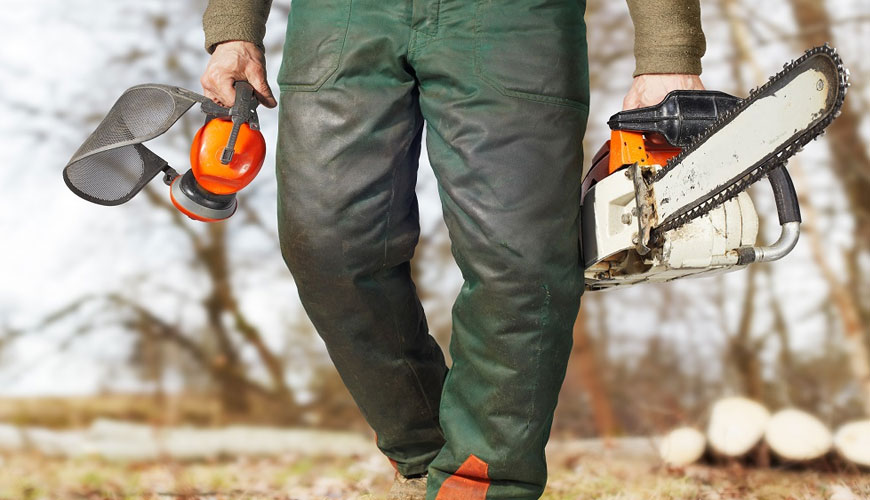

The ISO 11393 standard, published by the International Standards Organization (ISO), consists of the following subsections under the main title of "Protective clothing for hand-held chainsaw users":

The ISO 11393-1 standard describes a test setup for assessing the resistance to cutting of protective clothing, shoes and gloves by hand-held chainsaws. This standard also includes the calibration procedure. For the purposes of this standard
The ISO 11393-2 standard describes performance requirements, test methods, design requirements, and identification and marking information for leg protectors that protect against cuts by hand-held chainsaws. For the purposes of this standard,
The ISO 11393-3 standard describes test methods for assessing the resistance of shoes to cuts by hand-held chainsaws. This standard only applies to shoes with integrated protection. Methods for testing other forms of foot and leg protection against hand-held chainsaws, such as gaiters, are covered in other parts of this standard.
The ISO 11393-4 standard describes performance requirements, test methods, design requirements, and identification and marking information for gloves that protect against cuts by hand-held chainsaws. Information on the use of the chainsaw and the selection of gloves is included in the standard annex (Appendix A). For the purposes of this standard,
The ISO 11393-5 standard describes requirements and test methods for evaluating gaiters' resistance to cuts by hand-held chainsaws and other properties. This standard contains a requirement and a test method for evaluating the strength of the underfoot straps of leggings. This standard also applies to gaiters used with steel toe safety shoes conforming to “C” or “D” defined in ISO 20345 standard. These leggings are designed for use with a defined shoe model only and have been tested together. These products are designed for, but are not limited to, use with a defined orthopedic shoe model. Also, this standard does not apply to gaiters intended for use in situations where there is a significant risk of tripping, such as tree climbing or forests. For the purposes of this standard, gaiters refer to shoes with a removable cover intended to protect the forefoot, ankle and lower leg from being cut by a hand-held chainsaw.
The ISO 11393-6 standard describes performance requirements, test methods, design requirements, and identification and marking information for upper body protectors that protect against cuts by hand-held chainsaws. In addition, procedures are described for sampling and pretreatment of upper body protectors, measurement of protective coating, apparatus and test methods for assessing cut resistance, and practical performance testing for evaluating ergonomic properties. Guidance on the use of chainsaws and the selection of appropriate upper body protectors is included in the standard appendix (Annex A). For the purposes of this standard,
The ISO 11393 standard generally consists of a series of personal protective equipment designed to protect against the risks arising from the use of hand-held chainsaws, mainly produced for sawing wood.
Portable hand-held chainsaws are normally powered by electric or internal combustion engines. Experience has shown that it is difficult to determine the technical characteristics of a fuel-powered engine.
No personal protective equipment can provide complete protection against cuts from a hand-held chainsaw. However, experience has shown that it is possible to design personal protective equipment that offers a certain degree of protection.
Different functional principles can be applied to provide protection. These include:
Among the numerous test, measurement, analysis and evaluation studies it provides for businesses in various sectors, our organization also provides test services for hand-held chainsaw users, within the scope of ISO 11393 standard, with its trained and expert staff and advanced technological equipment.
To get an appointment, to get more detailed information or to request an evaluation, you can ask us to fill in our form and reach you.